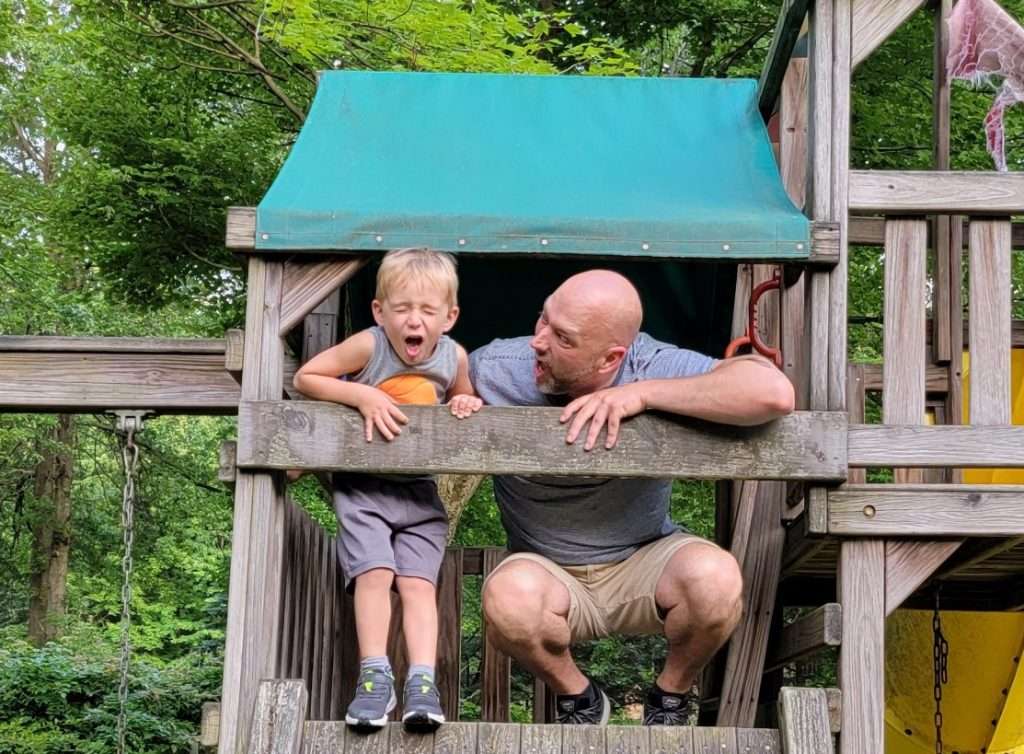From Autopilot to Awareness: How I Took Back Control of My Life
Have you ever found yourself moving through life on autopilot, wondering if this is all there is? You wake up each day, tackling your to-do list, managing the chaos, and surviving the daily grind. I used to feel like I was sleepwalking through life—trapped in the routines of survival, barely aware of the world around me. But somewhere in the middle of it all, something nags at you. It’s that subtle voice asking, “Is this all there is?” —a sense that maybe, just maybe, life holds more than just getting through each day.”
For me, that voice got louder during the most difficult moments of my life—especially through my divorce and the custody battle over my son, Tanner. I remember the day my ex-wife left vividly—the door closing behind her, the silence that followed, and the feeling of emptiness that settled in the house. It was as if the world had shifted, and I was left with nothing but the echo of my own thoughts.
In those moments, I felt completely consumed by emotions: anger, sorrow, and pain.

It’s easy to let your emotions run the show when you’re hurting. It’s harder to pause, take stock, and see the bigger picture.
Over time, I began to realize that there was a gap between what I was feeling and the life I wanted to live. I wanted to be more than reactive. I wanted to be more aware, more in control of how I navigated the tough stuff, and more deliberate about the choices I made moving forward. I wanted to create a version of myself that Tanner could look up to—not shaped by what life had thrown at me, but by the choices I made to rise above it. But to do that, I had to get real about where I was and where I wanted to go.
Learning to Live Wide Awake: A Battle with Autopilot
One of the biggest lessons I’ve learned is that awareness is an ongoing journey. There’s no magic switch that suddenly makes you fully present. It’s a muscle you have to build—and believe me, I’m still building it. Sometimes, I get caught up in my own thoughts or emotional patterns. But I’m getting better at catching myself when it happens. I notice when I’m lost in thought, and I bring myself back to what’s happening around me.
It sounds simple, but it’s not. Living in the moment requires intention. It’s about pulling yourself out of autopilot and becoming more attuned to what’s really going on—both within yourself and in your surroundings. When I get out of my head and into the present, I see things I might have missed before: my son’s smile lighting up the room, the way the sunlight dances on the trees, or even just the feeling of peace that comes from being still for a moment.

In those moments, I feel the warmth of the sun on my skin, hear the laughter of my son as it fills the room, and for a fleeting second, everything feels just right. I remember one evening, standing in the kitchen, my mind racing about everything I hadn’t done that day. Tanner ran up, tugging at my sleeve, asking me to play. I almost brushed him off, caught up in the noise of my own mind—but then I paused, knelt down, and looked into his eyes. It was that moment I realized being present with him was more important than any to-do list. His laughter as we played filled the room, and for the first time in a while, I truly felt alive. It might seem like a small thing, but after so long in the dark, these simple moments I used to take for granted have become everything.
As I began to embrace living in the present, I soon realized that being fully aware also meant facing and understanding my pain. I had to confront the root causes of my emotional turmoil, which led me to a powerful realization about awareness.
Turning Pain into Presence: How Awareness Became My Superpower
When I was younger, I didn’t have much patience for self-reflection. I would act on impulse, letting emotions dictate my decisions. It wasn’t until I started therapy—something I’ve been doing for the past six years—that I began to understand the power of awareness. Awareness isn’t just about noticing what’s going on; it’s about understanding why you feel the way you do and what you can do about it.
This was especially true during my divorce. When my ex-wife left, it rocked me. The sadness, anger, and grief felt overwhelming, and for a while, I let those emotions control me. I struggled with depression and even had suicidal thoughts at one point. It took time—more time than I’d like to admit—but I eventually reached a point of acceptance. I realized that I couldn’t control what had happened, and I certainly couldn’t control her choices. What I could control was how I responded.
That shift—from feeling powerless to understanding what was within my control—wasn’t immediate. But it marked the beginning of a transformation. I went from being at the mercy of my emotions to becoming someone who could sit with them, understand them, and move beyond them. It wasn’t just about surviving anymore; it was about thriving.
Awareness isn’t just valuable for the big, emotional moments—it makes a difference in the small, everyday ones too. I found myself able to respond more calmly when Tanner spilled juice on the couch, or when someone cut me off in traffic. Those small victories of choosing patience over frustration started adding up, changing how I experienced my daily life.
I’m learning to carry that mindset into other areas of my life. I still mess up sometimes, but instead of getting stuck, I pause, figure out what I can take from it, and keep moving forward. It’s not about getting everything perfect—it’s about making steady progress.
Have you ever felt powerless in the face of your emotions? What would it look like if you could choose a different response?
The Power of Reflection and Gratitude
Part of my journey toward greater awareness has been incorporating self-reflection and gratitude into my daily routine. Every day, I take time to jot down what I’m grateful for and reflect on the day’s events. It’s a small practice, but it helps me stay grounded. When I sit down at the end of the day and look back, I can see where I got caught up in old patterns and where I succeeded in staying present.
If you’re looking to start building your own awareness, try this: write down three things you’re grateful for each day, no matter how small. It could be the warmth of your morning coffee, a kind word from a stranger, or the way sunlight filters through your window. Consider setting a specific time each day to practice gratitude—like right after brushing your teeth in the morning or before bed. Associating it with a daily habit can make it easier to remember.
Try using prompts like: “What made me feel most alive today?” or “Where did I struggle to stay present?” to guide your reflections.

How would your life change if you made gratitude a daily practice? What small but powerful shifts might you start to notice?
These small moments matter, and they can make a big difference over time.
One especially rough day, I forced myself to sit down and find three things to be thankful for. It didn’t fix everything, but that simple act of reflection softened the stress and shifted my perspective. This practice has become even more important as I pursue my personal and professional goals. It helps me stay focused on what truly matters—building a life that reflects who I am and what I value, rather than one dictated by outside pressures.
Awareness: What It Is (And What It Isn’t)
Awareness isn’t about being perfectly mindful all the time. It’s not about avoiding negative emotions or being in a constant state of peace. Instead, awareness is about noticing what’s happening within you without judgment. It’s about understanding your feelings and choosing how to respond, even if it’s messy or imperfect.
Key Takeaways
- Awareness is a journey, not a switch—keep practicing.
- Gratitude and reflection help ground you in the present.
- Progress is about small, consistent actions, not sudden enlightenment.
- Awareness lets you shift from reacting on autopilot to responding with intention
- Self-reflection is the bridge between your current self and the person you want to become.
- Awareness helps you thrive, not just survive—it makes everyday moments richer.
- One of the affirmations I tell myself every day is: “I may not have control over everything, but I do have control over my response.” This simple reminder helps me stay focused on what matters.
Start Small, Stay Present
I won’t pretend to have it all figured out, but I do know this: awareness is the foundation for real change. Whether you’re navigating the challenges of parenthood, business, or personal growth, learning to pause, reflect, and be present can make all the difference. It’s in those mindful moments that real progress happens.
If you’re feeling stuck or overwhelmed, my advice is simple: start today.
Take just five minutes to sit quietly, breathe, and notice what’s happening around you. Jot down one thing you’re grateful for, and reflect on how you felt during your day. These small steps are your foundation for change.
You’re not alone on this journey. Every one of us gets lost in the noise, drifts from the present. But the real shift happens with those who choose, again and again, to come back. Give yourself those five minutes today to breathe, to reflect, to reconnect—because this is where real change begins.
Breaking free from autopilot isn’t a one-time effort; it’s a daily choice. Remember, even the smallest steps towards awareness are seeds that will grow over time, shaping a life you’ll want to live fully. Keep going, one small choice at a time.
No one wakes up one day fully aware and enlightened. But every time you catch yourself drifting and come back to the present, you’re rewriting your story.
We’re all a work in progress. And that’s okay. So keep going, even on the hard days. Because these small, mindful choices are building a life of purpose—one that’s truly yours.
